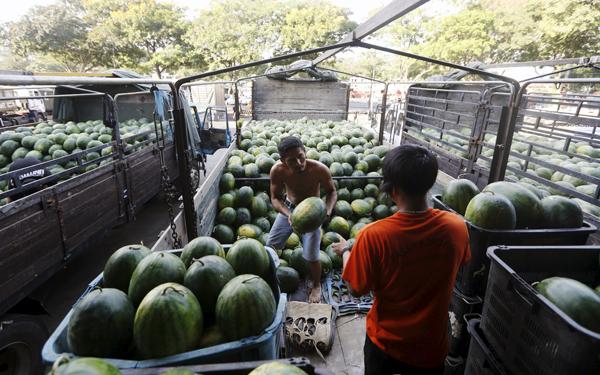You are here
Food prices plunge in 2015 on high supply, low demand, strong dollar
By Reuters - Jan 08,2016 - Last updated at Jan 08,2016

Workers unload watermelons at a wholesale market in Kuala Lumpur, Malaysia, on Thursday (Reuters photo)
ROME — Global food prices plunged 19 per cent in 2015 following a fresh decline in December on the back of plentiful supplies and a slowing global economy, the United Nations Food and Agriculture Organisation (FAO) said on Thursday.
It was the fourth consecutive annual fall in food prices.
The FAO's food price index, which measures monthly changes for a basket of cereals, oilseeds, dairy products, meat and sugar, averaged 154.1 points in December versus a revised 155.6 points the month before, a fall of some 1 per cent.
"Abundant supplies in the face of a timid world demand and an appreciating dollar are the main reason for the general weakness that dominated food prices in 2015," said FAO senior economist Abdolreza Abbassian.
December's reading was dragged down by falling prices for meat, dairy and cereals, which counterbalanced gains in quotations for sugar and vegetable oils.
Expectations of high supply of cereal following the removal of export taxes in Argentina weighed on wheat prices, and maize prices fell as export competition intensified and international demand remained sluggish.
The dedicated cereal price index shed 15.4 per cent in the course of the year, vegetable oils dropped to a nine-year low and dairy prices registered their lowest annual average since 2009.
Sugar prices rose 0.6 per cent in December but on average throughout the year were 21 per cent lower than in 2014.
Separately, researchers said that droughts and extreme heat have cut national cereal production by 9 to 10 per cent on average around the world in the last half-century, and the impact has worsened since the mid-1980s.
Cereal production losses averaged 13.7 per cent in drought years from 1985, compared with 6.7 per cent during earlier droughts, a new study published in the journal Nature found.
It examined the effects of some 2,800 weather disasters on 16 cereals in 177 countries from 1964 to 2007.
The trend could be due to any combination of rising drought severity, although whether droughts have got worse is still under debate, increasing vulnerability and exposure to drought, and greater reporting of drought events, the researchers indicated.
The study highlights the urgency for the global cereal production system to adapt to extremes in a changing climate, they said.
"Our findings may help guide agricultural priorities and adaptation efforts, to better protect farming systems and the populations that depend on them," said senior author Navin Ramankutty, professor of global food security and sustainability at the University of British Columbia.
The analysis did not identify any impact on crop production from floods and extreme cold in national data, they noted.
While the damage to cereal production from droughts and extreme heat was considerable, the effect was short-term, as agricultural output rebounded and continued to grow after the disasters, the study showed.
Droughts, which can last for several years, appear to be more harmful, reducing cereal yield and causing complete crop failure in some areas, whereas extreme heat only affected yield, it said.
Rich countries suffer
According to the study, production took a bigger hit from extreme weather in technically advanced agricultural systems in North America, Europe and Australasia than in developing countries.
In wealthy nations, production dropped by nearly 20 per cent due to droughts, double the global average.
In comparison, the average production deficit was around 12 per cent in Asia and just over 9 per cent in Africa, while extreme weather had no significant effect in Latin America and the Caribbean, the study indicated.
This could be explained by the differing approaches of large and small-scale farming, the authors said.
"Across the breadbaskets of North America, for example, the crops and methods of farming are very uniform across huge areas, so if a drought hits in a way that is damaging to those crops, they will all suffer," explained Corey Lesk, a recent graduate of McGill University.
"By contrast, in much of the developing world, the cropping systems are a patchwork of small fields with diverse crops. If a drought hits, some of those crops may be damaged, but others may survive," Lesk said.
As farmers in wealthier countries rarely depend on harvests for food and can usually insure crops against bad weather, the best strategy for them may be to maximise yields rather than minimise the risk of weather-related crop damage, as subsistence farmers would seek to do, the researchers concluded.
Related Articles
ROME — Global food commodity prices rose sharply in November to their highest level in nearly six years, the UN food agency said on Thursday
PARIS — World food prices fell in 2023, with considerable declines for grains and oils as supply concerns eased, the UN's Food and Agricultu
SIDI RACHED, Algeria — At Ahmed Bekhi's cereal farm outside Algiers, there are clear signs of Algeria's campaign to increase food production

















